
Asmara industrial
Adam Lacina
Asmara became the industrial center of Africa thanks to Mussolini's vision of dominating the Horn of Africa and building a new Roman Empire. At that time, Eritrea was primarily an Italian military base from which Ethiopia was to be conquered, and more and more soldiers and necessary civilians were drawn here. It was also necessary to transport materials here. Thus, in 1937, a cable car was built. It rose from the Red Sea, from Massawa, high up to Asmara. It was a perfect engineering feat, overcoming a difference in altitude of nearly 2500 m, with a length of 72 km, and could transport up to 730 tons of material in a single day. Another industrial gem was the railway, whose story is both a testament to Italian engineering prowess and post-war decline. At its greatest glory, locomotives traveled over 65 bridges and viaducts and passed under more than 20 tunnels. It was an unforgettable ride, where in 80 kilometers you overcome an elevation of 2500 meters and find yourself in a completely different world. From modern European-style Asmara, which is rich in greenery and has a fresh climate, you reach the Red Sea, in Massawa. A port with "Moorish" architecture that is one of the hottest places on earth. To a parched city where average summer temperatures hover around a staggering 40 °C in the shade.
By the late 1930s, Asmara was one of the most developed cities in Africa, attracting Italian companies like Alfa Romeo, Fiat, and Lancia. A network of asphalt roads was built, and there were even more street lamps than in Rome itself. The years following World War II were not so flattering. Due to prolonged struggles for independence, many industrial buildings and infrastructure deteriorated. The last witnesses passed away, and some industrial corners now feel like ghost towns.
Fiat Workshop and Service
Architect: Giuseppe Pettazzi
Realization: 1938
Certainly the most striking building in Asmara, built in a futuristic style, bears a resemblance to the design of a gas station in Minnesota by Frank Lloyd Wright. This Fiat station contained a workshop, garages, a gas station, and a small office. This "concrete airplane" is associated with a legend about the architect's stubbornness. In the plans, 30-meter wings were supported by concrete pillars. However, after the building was completed, Giuseppe Pettazzi decided to remove them, much to the displeasure of the investor. The argument allegedly ended with a gun to the investor's head, who then supported the pillars himself, and the station stands today. Unfortunately, the entire building is now non-functional, but it has been restored, with even the stylish 1930s lettering preserved.
Alfa Romeo Building
Architect: unknown
Realization: approximately 1937
Alfa Romeo was one of the first companies to invest in Eritrea. This building served as offices, garages, and apartments for company employees. It was constructed in a rationalist style with a dominant facade and wings spreading to the sides, enclosing a courtyard behind. Today it is in quite poor condition. One of the few elements that has remained intact is the sign above the facade reading Alfa Romeo.
Silicone Factory
Architect: Carlo Marchi & Carlo Montalbetti
Realization: 1938
The central tower, illuminated at night, had to be like a lighthouse for cars returning from the south. It also served as a water reservoir, and on the ground floor, there was a small glass office. The entire factory, one of the most modern buildings of its time, once belonged to the Italian company Lancia. It served as a complex of housing, service stations, workshops, and a car dealership. It is now in fairly good condition and still does not hide its progressiveness and dynamism of the era.
Shell Gas Station
Architect: unknown
Realization: 1937
The first gas station in Asmara appears like a surfacing submarine when arriving from the south. Round windows and an elliptical floor plan characterize the nautical style that peaked here in the 1930s. Similarly in Eritrea. Originally, this station was operated by Agip, which had dozens of similar stations across the country. However, the Asmara station is the largest and architecturally the boldest.
Fiat Depot
Architect: unknown
Realization: unknown
The splendid and impressive depot of Fiat seems to still be operational. It houses garages, a car wash, and a repair shop. The modernistically curved brick facade is dynamically striking and invites entry. The combination of blue color and bare bricks is pleasing to the eye of every driver. Again, beautiful lettering above the entrance has been preserved.
Offices of British and American Tobacco Group
Architect: unknown
Realization: probably 1938
The building still serves its original purpose. But many other things have changed. Ribbon windows have been replaced with regular ones, fascist symbols next to the entrance have been removed, the color has changed, and the facade from the street is shaded by palm trees. But this dynamic building still retains the spirit of its time.
By the late 1930s, Asmara was one of the most developed cities in Africa, attracting Italian companies like Alfa Romeo, Fiat, and Lancia. A network of asphalt roads was built, and there were even more street lamps than in Rome itself. The years following World War II were not so flattering. Due to prolonged struggles for independence, many industrial buildings and infrastructure deteriorated. The last witnesses passed away, and some industrial corners now feel like ghost towns.
Fiat Workshop and Service
Architect: Giuseppe Pettazzi
Realization: 1938
Certainly the most striking building in Asmara, built in a futuristic style, bears a resemblance to the design of a gas station in Minnesota by Frank Lloyd Wright. This Fiat station contained a workshop, garages, a gas station, and a small office. This "concrete airplane" is associated with a legend about the architect's stubbornness. In the plans, 30-meter wings were supported by concrete pillars. However, after the building was completed, Giuseppe Pettazzi decided to remove them, much to the displeasure of the investor. The argument allegedly ended with a gun to the investor's head, who then supported the pillars himself, and the station stands today. Unfortunately, the entire building is now non-functional, but it has been restored, with even the stylish 1930s lettering preserved.
Alfa Romeo Building
Architect: unknown
Realization: approximately 1937
Alfa Romeo was one of the first companies to invest in Eritrea. This building served as offices, garages, and apartments for company employees. It was constructed in a rationalist style with a dominant facade and wings spreading to the sides, enclosing a courtyard behind. Today it is in quite poor condition. One of the few elements that has remained intact is the sign above the facade reading Alfa Romeo.
Silicone Factory
Architect: Carlo Marchi & Carlo Montalbetti
Realization: 1938
The central tower, illuminated at night, had to be like a lighthouse for cars returning from the south. It also served as a water reservoir, and on the ground floor, there was a small glass office. The entire factory, one of the most modern buildings of its time, once belonged to the Italian company Lancia. It served as a complex of housing, service stations, workshops, and a car dealership. It is now in fairly good condition and still does not hide its progressiveness and dynamism of the era.
Shell Gas Station
Architect: unknown
Realization: 1937
The first gas station in Asmara appears like a surfacing submarine when arriving from the south. Round windows and an elliptical floor plan characterize the nautical style that peaked here in the 1930s. Similarly in Eritrea. Originally, this station was operated by Agip, which had dozens of similar stations across the country. However, the Asmara station is the largest and architecturally the boldest.
Fiat Depot
Architect: unknown
Realization: unknown
The splendid and impressive depot of Fiat seems to still be operational. It houses garages, a car wash, and a repair shop. The modernistically curved brick facade is dynamically striking and invites entry. The combination of blue color and bare bricks is pleasing to the eye of every driver. Again, beautiful lettering above the entrance has been preserved.
Offices of British and American Tobacco Group
Architect: unknown
Realization: probably 1938
The building still serves its original purpose. But many other things have changed. Ribbon windows have been replaced with regular ones, fascist symbols next to the entrance have been removed, the color has changed, and the facade from the street is shaded by palm trees. But this dynamic building still retains the spirit of its time.
The English translation is powered by AI tool. Switch to Czech to view the original text source.
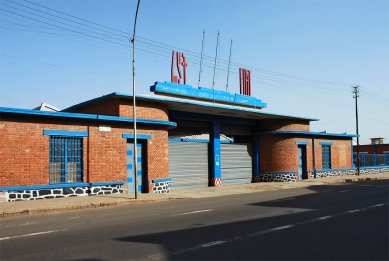

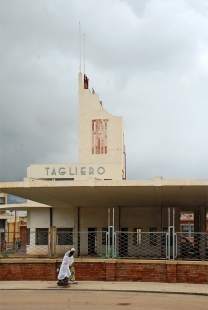
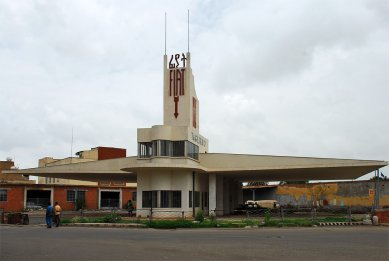
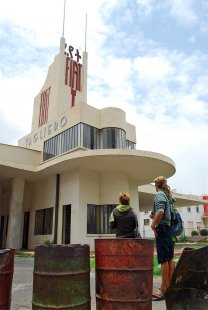
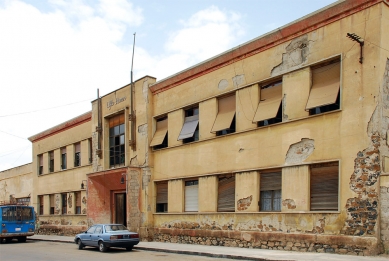
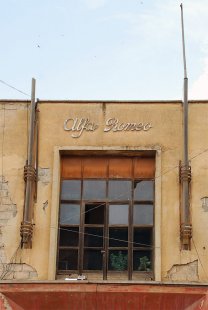
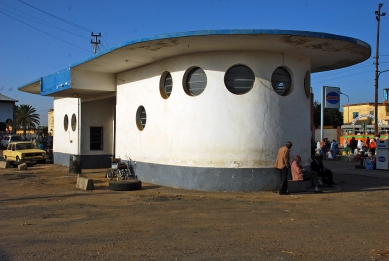
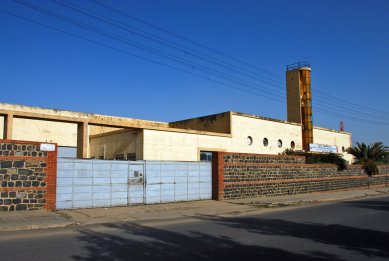
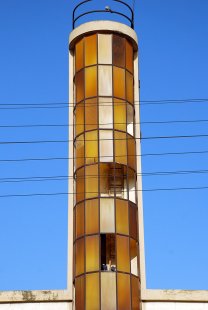
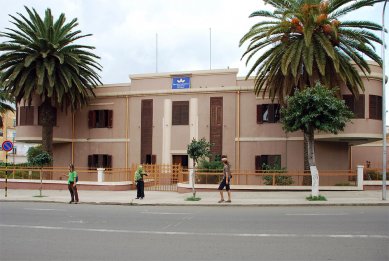
0 comments
add comment







